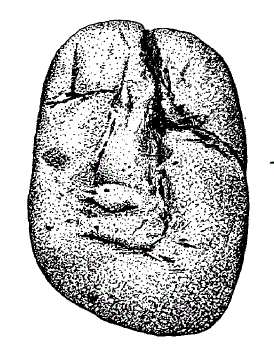MANKIND'S OLDEST SHRINE DISCOVERED IN SPAIN
By TOM FERRELL
American and Spanish scientists have reported finding the earliest intact religious sanctuary from the early Stone Age at El Juyo Cave, an archeological site in northern Spain near the seaport city of Santander.
The scientists said they believe the sanctuary was built 14,000 years ago, which would make it mankind's oldest known religious shrine. Other than burial sites, the previous oldest known shrines are in the Middle East and are about 9,000 years old.
The El Juyo sanctuary contains a free-standing sculptured stone head, interpreted by the scientists as that of a supernatural being. On one side of the sculpture is the visage of a human being, and on the other is that of an animal, probably a cat.
Scholars had long hoped to find evidence that would clearly show the existence of religious behavior or ritual in the Paleolithic Era. Cave paintings, decorated artifacts and burial offerings, many archeologists believe, suggest religious belief but in many cases may have alternative interpretations.
The El Juyo sanctuary, details of which were published this summer by the Spanish Ministry of Culture and by the History of Religion, an American journal, was discovered by Dr. Leslie G. Freeman and Dr. Richard G. Klein, both anthropologists at the University of Chicago; by Dr. J. Gonzalez Echegaray, director of the Altamira Museum and Research Center in Santillana, Spain, and by Dr. I. Barandiaran of the University of Santander.
The excavation was financed by the Spanish Ministry of Culture and the United States National Science Foundation. The site has been known since 1957 as the home of a late Paleolithic culture called Magdalenian III, which flourished about 14,000 years ago. The sanctuary occupied about 120 square feet just inside the mouth of the cave.
A shallow trench was found in the center of the complex, containing animal bones, new and unused spearheads and other artifacts. Atop the trench was a mound about 30 inches high that contained similar ''offerings of bones, spearheads and other artifacts, Dr. Freeman said, alternating with layers of carefully arranged rosettes of earth.
''It was as if the builders had scooped earth into small cups or buckets about 4 inches across, and then inverted them on top of the mound,'' Dr. Freeman said yesterday in a telephone interview. ''One circle of earth was in the center, surrounded by six more circles, their edges just touching.''
The mound itself was plastered over with a clay shell, and above this was a horizontal limestone slab 71 inches long, 47 inches wide and 6 inches thick, Dr. Freeman said, adding that the slab weighed nearly a ton.
The sculpture, 14 inches tall, was placed on a smaller mound facing the cave entrance, he said. A natural vertical fissure of the rock was used to divide the stone face into two parts: on one side, the half-face of a man with a moustache and beard; on the other, the half-face of a carnivore, most likely a lion or a leopard, with muzzle, whiskers and a single pointed tooth.
The conclusion that the site is a religious sanctuary rests on several factors, Dr. Freeman said. Noting that a sanctuary is defined as a place where some kind of collective sacred behavior takes place, he said the collectivity was demonstrated by the large stone.
''Given the amount of work required to move the limestone slab, at least 10 to 15 individuals must have participated in building the sanctuary,'' he said. ''It was a group undertaking, and that suggests a shared system of group beliefs.''
Dr. Freeman conceded that ''there could be a lot of collectively built monuments one wouldn't call ritual, if you can explain them as having some kind of technical economic use,'' and noted that many arrangements of large stones, in Europe and elsewhere, were clearly designed for the observation of astronomical events.
''But El Juyo is not explicable in economic terms,'' Dr. Freeman said. ''There's a whole lot of effort going on, none of which is visible after the structure is built. It is not economic activity.
''A final element in the definition of a sanctuary would be that these activities have to be designed to influence a culturally postulated supernatural being,'' the anthropologist said. ''There is a figure here, the stone sculpture. At a distance it looks like a human face, but when you get closer you find that it's got two natures, the human and the animal.''
The divided face of the sculpture, Dr. Freeman suggests, might have been meant to ''represent an awareness among the group of the difference between what is animal and what is human, and at the same time a fusion of the savage, instinctive side of life with the human, more culturally ordered side.''
Pietro Gaietto illustration (
http://www.museoorigini.it) of the interpreted human/animal characteristics of the stone face carving from El Juyo cave, near Santander, Spain.
Mark Jones find, Piney Point, Maryland, in context of many "one open, one eye shut" stone figures (left) compared to El Juyo stone face (right). Both faces have similar "nostril divots."









.jpg)
.jpg)












.JPG)


.jpg)
